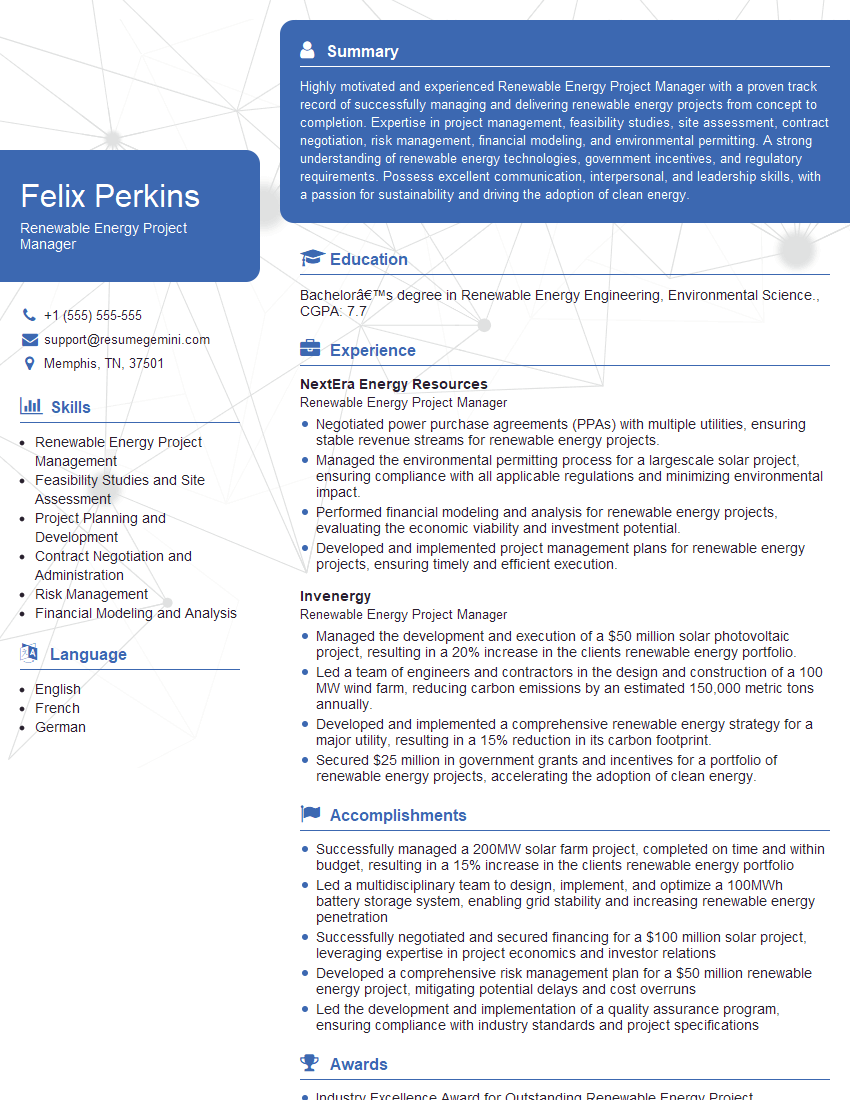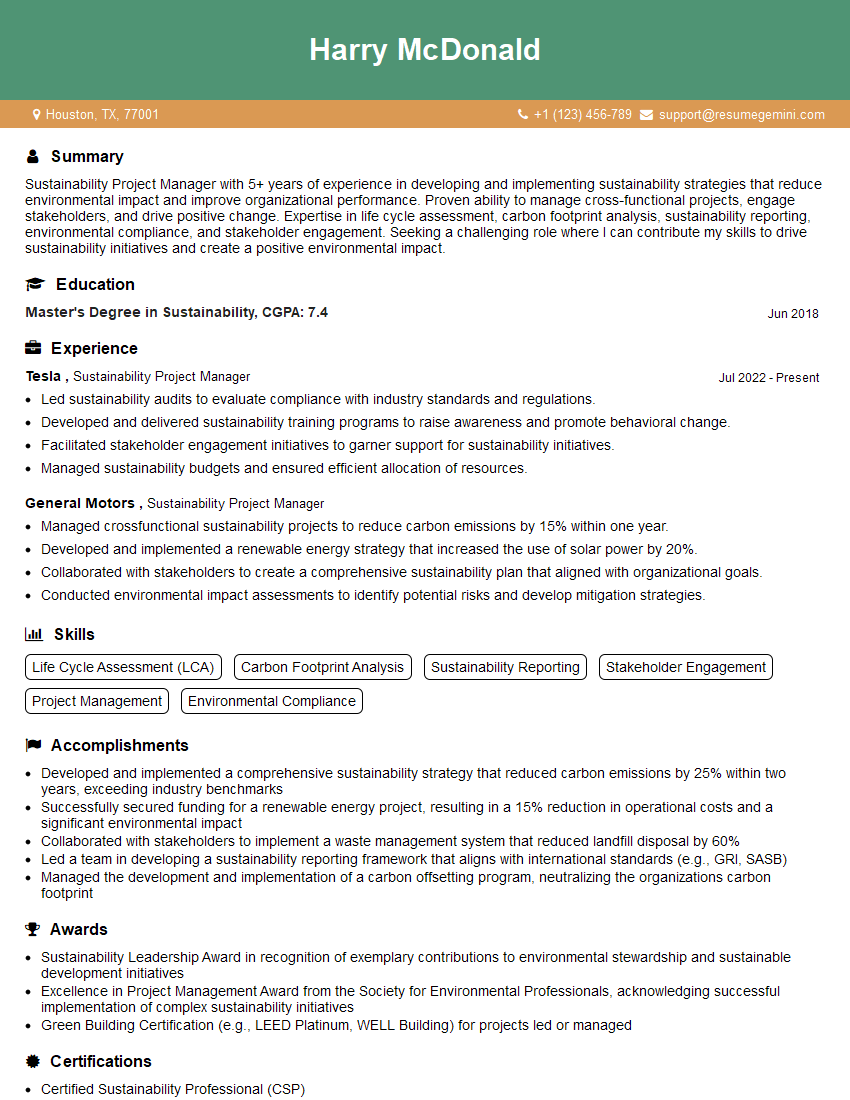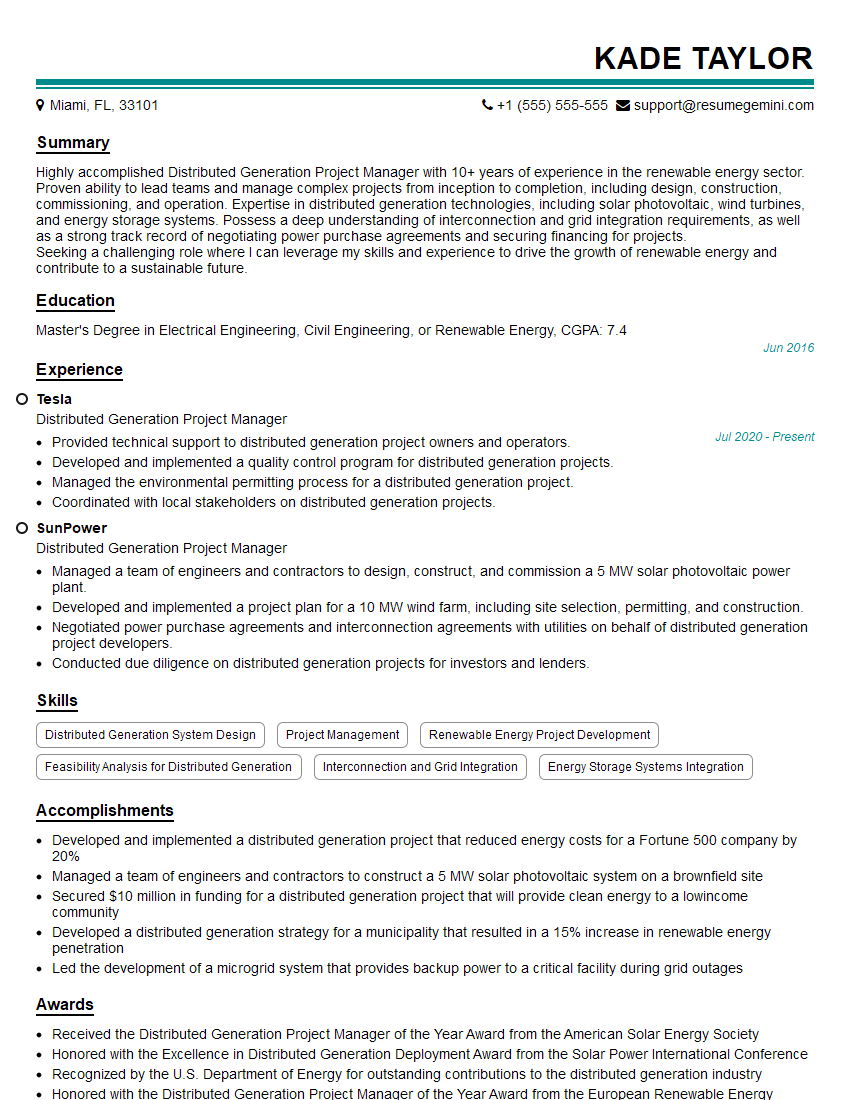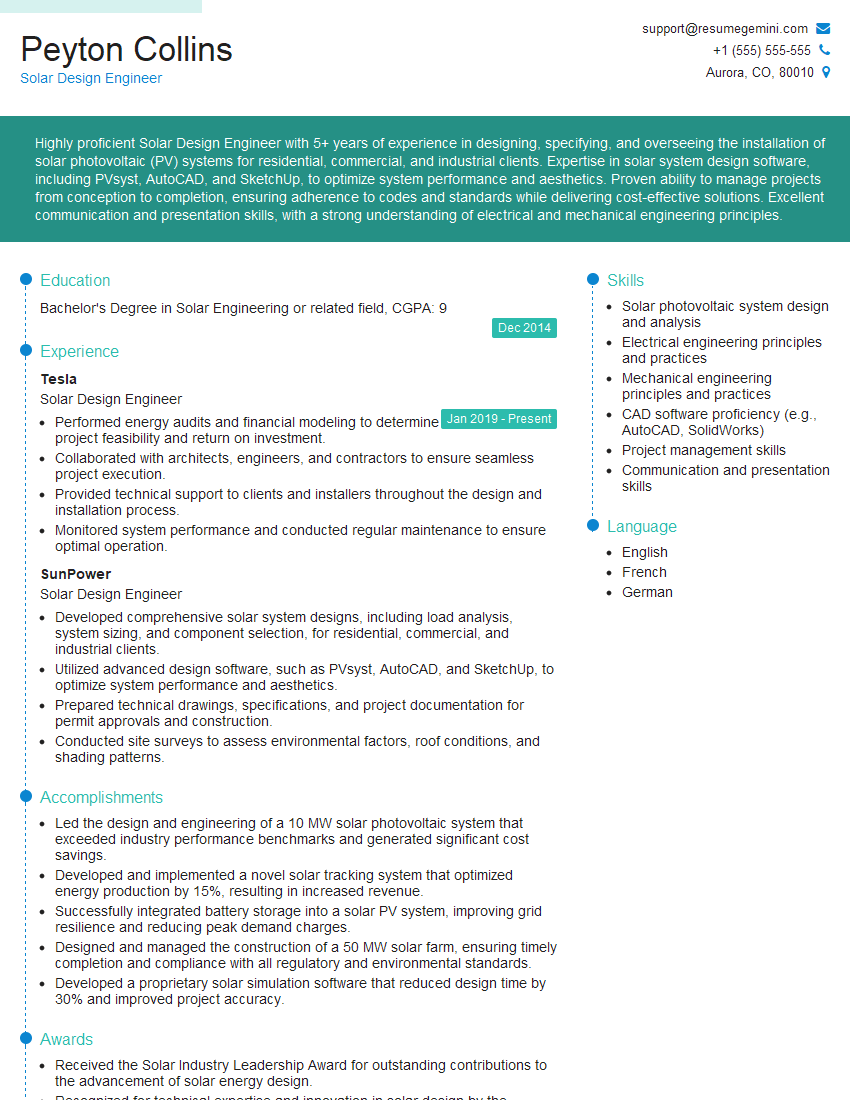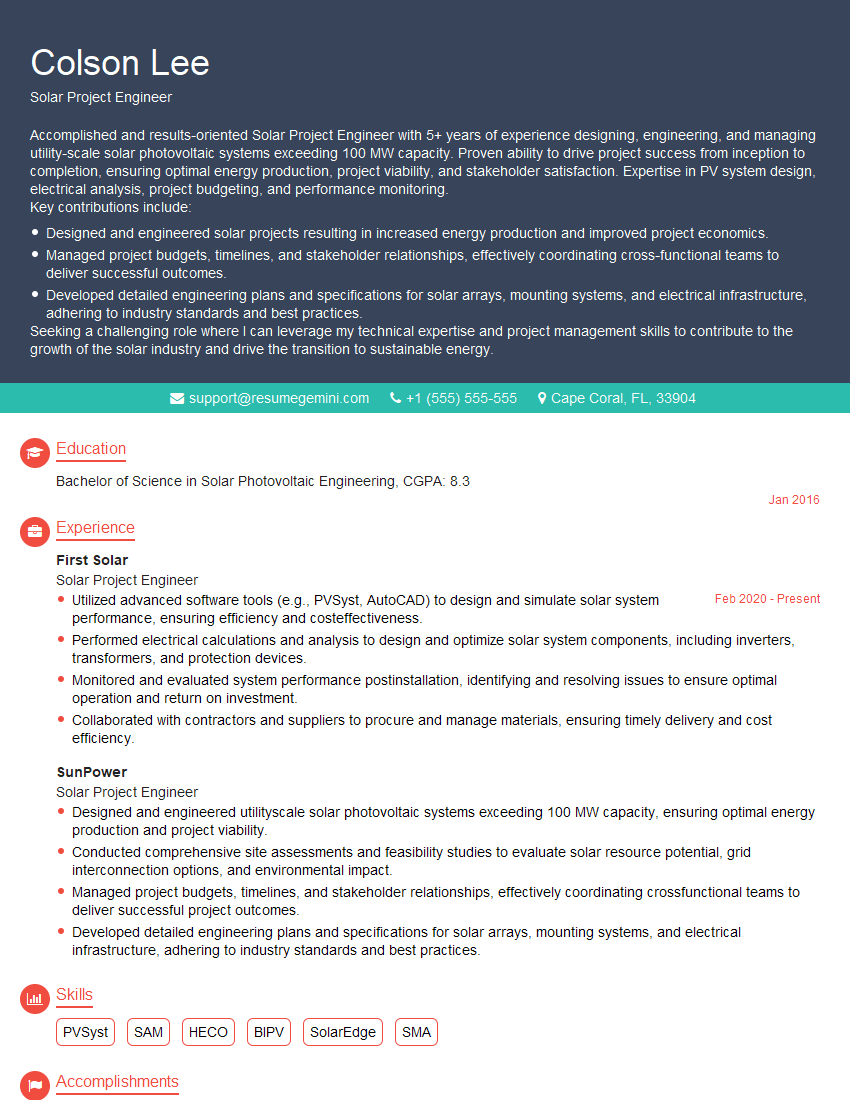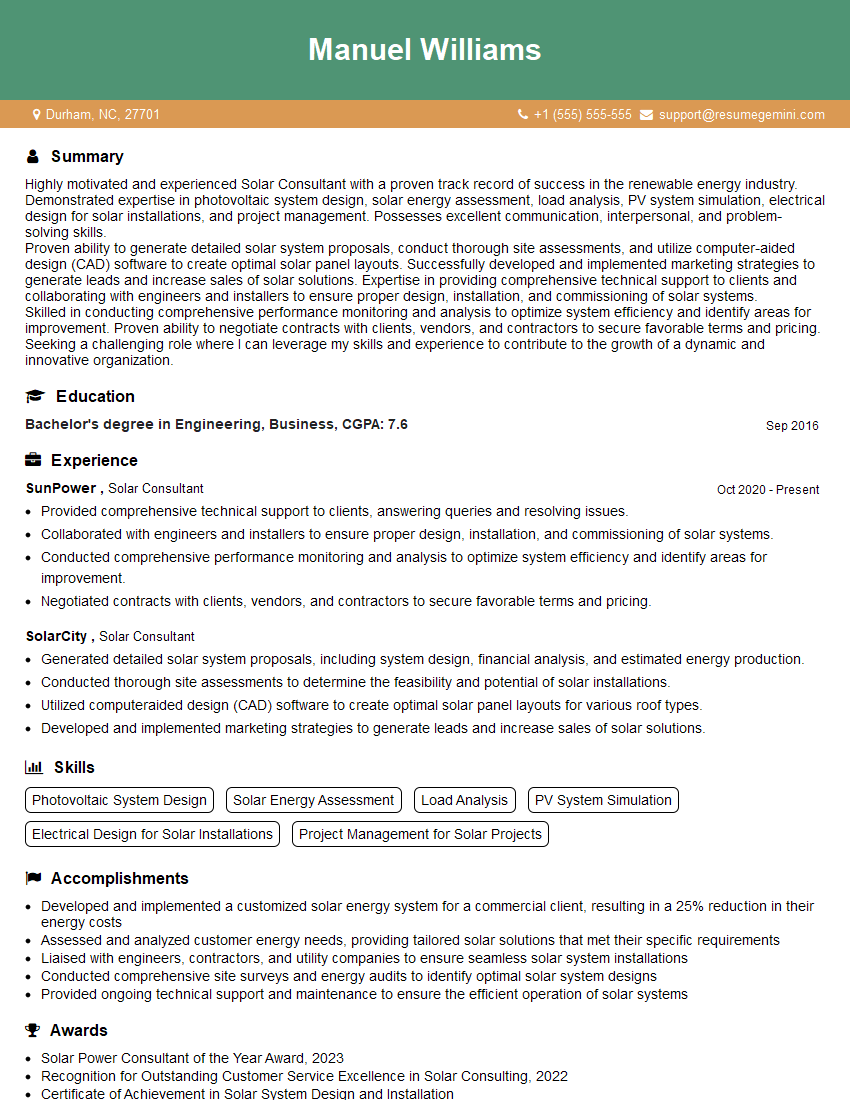Preparation is the key to success in any interview. In this post, we’ll explore crucial Solar Project Development and Management interview questions and equip you with strategies to craft impactful answers. Whether you’re a beginner or a pro, these tips will elevate your preparation.
Questions Asked in Solar Project Development and Management Interview
Q 1. Describe your experience with solar project feasibility studies.
Solar project feasibility studies are crucial for determining the viability of a solar energy project. They involve a thorough assessment of various factors to predict the project’s success. This includes a detailed technical analysis, financial modeling, and market research. Think of it as a comprehensive pre-construction check-up.
My experience encompasses conducting numerous feasibility studies, evaluating factors such as solar irradiance levels using tools like PVsyst or Helioscope, analyzing land availability and suitability, assessing grid connection feasibility, and preparing detailed financial models that project returns on investment (ROI). For example, in a recent project, we used detailed GIS analysis to assess shading from surrounding trees, potentially impacting yield by 15%, a factor which we mitigated in our final design recommendations. Ultimately, we prepare comprehensive reports recommending ‘go’ or ‘no-go’ decisions, backed by robust data.
Q 2. Explain the different stages of solar project development.
Solar project development follows a structured process. It’s like building a house – you wouldn’t start with the roof! It typically involves these key stages:
- Site Assessment and Selection: This includes analyzing solar irradiance, land availability, grid connection possibilities, environmental impact, and permitting requirements.
- Engineering and Design: This stage involves designing the solar array layout, selecting specific components (panels, inverters, racking systems), and developing detailed engineering drawings.
- Permitting and Approvals: Securing the necessary permits and approvals from local authorities, utility companies, and other relevant stakeholders. This can be a time-consuming but critical step.
- Financing and Procurement: Securing project financing through loans, equity investments, or power purchase agreements (PPAs). This stage also involves purchasing the required equipment.
- Construction and Installation: This stage encompasses site preparation, foundation work, module installation, electrical work, and system commissioning.
- Commissioning and Testing: A thorough verification that the system performs as designed, followed by system handover.
- Operation and Maintenance (O&M): Post-construction monitoring, maintenance, and performance tracking of the solar system.
Q 3. What are the key performance indicators (KPIs) you track in solar projects?
Key Performance Indicators (KPIs) are vital for monitoring a solar project’s health and success. Think of them as a project’s vital signs. We meticulously track several key metrics:
- Energy Yield: Actual energy produced versus projected energy output (kWh).
- Capacity Factor: The percentage of time the system is operating at its maximum capacity.
- Performance Ratio (PR): A measure of system efficiency, reflecting energy losses from various sources.
- System Availability: The percentage of time the system is operational and available to generate power.
- Specific Yield: Energy generated per kWp of installed capacity.
- Return on Investment (ROI): The profitability of the investment over time. We regularly compare our actual ROI to the projected ROI based on the feasibility study.
- Levelized Cost of Energy (LCOE): The average cost of producing energy over the life of the project.
These metrics are tracked through SCADA systems (Supervisory Control and Data Acquisition), providing real-time data and allowing for proactive issue identification.
Q 4. How do you manage project risks and uncertainties in solar development?
Risk management is paramount in solar project development. Unforeseen issues can derail a project. My approach involves a proactive and multi-layered strategy:
- Risk Identification: Identifying potential risks throughout all project phases, including weather events, permitting delays, equipment failures, and financing issues.
- Risk Assessment: Evaluating the likelihood and potential impact of each identified risk.
- Risk Mitigation: Developing strategies to reduce the likelihood or impact of identified risks. For instance, using insurance to cover potential weather damage or securing multiple financing options to prevent delays.
- Contingency Planning: Developing alternative plans for addressing potential disruptions. Having backup suppliers for equipment and maintaining open communication lines with stakeholders.
- Monitoring and Reporting: Regularly tracking identified risks, and implementing corrective actions as needed. A well-documented risk register is crucial for this process.
For example, one project faced unexpected delays due to permitting issues. By proactively engaging with regulatory authorities and utilizing our contingency plan, we were able to minimize the delay’s impact on the overall project timeline and budget.
Q 5. What are your preferred project management methodologies (e.g., Agile, Waterfall)?
While Agile methodologies emphasize flexibility and iterative development, a hybrid approach is often best suited for solar projects. This is because while the core design requires a structured approach (Waterfall), the procurement and construction phases benefit from Agile’s adaptability to change.
We typically employ a modified Waterfall approach for the initial phases (site selection, design, permitting), ensuring a comprehensive and well-defined plan. Once equipment procurement and construction begin, we incorporate Agile principles, allowing for quicker response to unforeseen challenges and ensuring better flexibility in managing resources.
This hybrid approach ensures that the project maintains a strong foundation while also allowing for the necessary flexibility and responsiveness to the dynamic nature of solar projects.
Q 6. Describe your experience with solar panel technology and its advancements.
Solar panel technology is constantly evolving, improving efficiency and reducing costs. My experience spans several generations of panels, from traditional crystalline silicon to emerging technologies such as thin-film and perovskite.
I’m well-versed in the characteristics of different panel types, including their power output, temperature coefficients, and degradation rates. For example, I’ve worked with projects utilizing both monocrystalline and polycrystalline silicon panels, selecting the most cost-effective option based on specific site conditions and budget constraints. We also investigate the use of bifacial panels that capture sunlight from both sides, offering enhanced energy yields. Staying abreast of technological advancements is crucial for optimizing project design and ensuring long-term performance.
Q 7. How do you handle stakeholder communication and management in solar projects?
Stakeholder management is a critical aspect of solar project development. Successful projects require open and transparent communication with all parties involved.
My approach focuses on:
- Regular Communication: Establishing clear communication channels and providing regular updates to all stakeholders, including landowners, investors, utility companies, and local communities. We often use project management software to centralize communication and ensure timely updates.
- Active Listening: Actively listening to stakeholder concerns and addressing them promptly and effectively. This promotes trust and collaboration.
- Relationship Building: Cultivating strong relationships with all stakeholders to facilitate cooperation and overcome potential obstacles. Regular meetings and transparent communication are key to this.
- Conflict Resolution: Developing strategies for addressing and resolving conflicts in a fair and constructive manner.
- Community Engagement: Engaging with local communities to address concerns and build support for the project. This might involve public forums and educational initiatives.
Effective stakeholder management builds trust, reduces conflicts, and ultimately leads to a more successful project.
Q 8. Explain your experience with solar energy permitting and regulatory compliance.
Navigating the complex landscape of solar energy permitting and regulatory compliance is crucial for project success. My experience encompasses all phases, from initial site assessment and feasibility studies to securing all necessary approvals and permits before commencing construction and operation. This involves a deep understanding of local, state, and federal regulations, including building codes, zoning ordinances, interconnection standards, and environmental impact assessments.
For example, in a recent project, we encountered challenges securing a permit due to the proximity of a protected bird habitat. To overcome this, we collaborated with environmental consultants to conduct a comprehensive avian impact study, which demonstrated that our proposed design minimized potential risks. This, combined with careful documentation and adherence to all relevant guidelines, allowed us to obtain the necessary permit.
My approach involves proactive engagement with regulatory bodies throughout the project lifecycle, ensuring transparent communication and addressing potential challenges early on. This proactive approach significantly reduces delays and potential project cost overruns.
- Thorough due diligence to identify all relevant regulations early in the project.
- Preparation of comprehensive permit applications supported by detailed documentation and technical reports.
- Maintain transparent communication with regulatory agencies.
- Regular monitoring of regulatory updates and compliance changes.
Q 9. How do you ensure the financial viability of a solar project?
Ensuring the financial viability of a solar project requires a multi-faceted approach that considers all aspects of the project’s lifecycle, from initial investment to long-term operational costs and revenue generation. This includes thorough due diligence, meticulous financial modeling, and risk mitigation strategies.
My strategy involves developing detailed financial models that incorporate factors such as capital costs, operational expenses, energy production estimates (considering factors like solar irradiance, system degradation, and shading), projected energy prices, and available incentives and subsidies (e.g., tax credits, PPAs). Sensitivity analysis is crucial to identify areas of greatest financial risk and explore alternative scenarios. For example, we might model variations in energy production due to weather patterns or changes in government incentives.
Furthermore, securing favorable financing terms is essential. This involves exploring a variety of financing models (discussed in a later answer) and demonstrating the project’s robust financial profile to potential investors and lenders. Risk mitigation strategies are also essential, including comprehensive insurance policies and robust project management to ensure the project stays on schedule and within budget.
Q 10. What are your strategies for cost optimization in solar projects?
Cost optimization in solar projects is an ongoing process that begins during the initial design phase and continues throughout the project’s lifecycle. My approach is multifaceted and involves optimizing every aspect of the project from the selection of equipment and materials to construction methodologies and operational procedures.
Strategies include:
- Optimizing system design: Careful consideration of array layout, tilt angles, and shading analysis to maximize energy production while minimizing the number of panels needed.
- Competitive procurement: Sourcing equipment and materials from multiple vendors to ensure competitive pricing and secure favorable contracts.
- Efficient construction methods: Utilizing skilled labor and streamlined construction processes to minimize labor costs and project duration.
- O&M optimization: Implementing preventative maintenance programs to minimize downtime and extend the lifespan of the system.
- Leveraging available incentives: Exploring all applicable tax credits, rebates, and other incentives to reduce the initial investment costs.
For example, in a recent project, we were able to achieve a 15% cost reduction by optimizing the system design and adopting innovative construction techniques. This involved utilizing pre-assembled racking systems and implementing a standardized installation process.
Q 11. Describe your experience with solar energy procurement and supply chain management.
Effective solar energy procurement and supply chain management are critical for on-time and within-budget project delivery. My experience encompasses all aspects of this process, from identifying and vetting qualified suppliers to negotiating contracts and managing logistics.
My approach involves establishing a robust procurement process that begins with detailed specifications and drawings, followed by a thorough evaluation of potential suppliers based on factors such as quality, reliability, price, and lead times. We use a competitive bidding process to ensure we obtain the best possible pricing and contractual terms.
Supply chain risk management is also a key consideration. We develop contingency plans to address potential supply chain disruptions, such as geopolitical events or material shortages. This includes securing alternative suppliers and building in buffer time for potential delays. Tracking and monitoring equipment shipments is essential to avoid construction delays and ensure components are delivered to the site on schedule.
For instance, in a recent project, we successfully navigated a global shortage of certain solar panel models by proactively securing alternative panels from a different supplier. This required meticulous planning and close collaboration with our suppliers to ensure a seamless transition and avoid any project delays.
Q 12. How do you manage solar project schedules and deadlines effectively?
Effective solar project scheduling and deadline management hinges on detailed planning, diligent monitoring, and proactive risk mitigation. I use a combination of project management methodologies, including Agile and Waterfall, tailoring the approach to the specific project needs and complexity.
The process begins with a detailed work breakdown structure (WBS) that outlines all project tasks and their dependencies. We then use project management software to create a critical path schedule, identifying tasks critical to the project completion. This allows for clear visibility of potential bottlenecks and dependencies. Regular progress monitoring meetings are held to track milestones and identify potential issues early.
Proactive risk management is crucial. We identify potential risks, such as weather delays or equipment shortages, and develop mitigation strategies. For instance, in a project impacted by unexpected weather delays, we proactively adjusted the schedule and reallocated resources to minimize the impact on the overall project timeline. Regular communication with all stakeholders is paramount, ensuring everyone is aligned on project progress and potential challenges.
Q 13. Explain your experience with solar energy grid integration and interconnection.
Solar energy grid integration and interconnection are critical for successful project operation. My experience covers all aspects of this process, from initial interconnection studies to obtaining interconnection agreements and commissioning the system.
The process starts with a detailed interconnection study to assess the technical feasibility of connecting the solar system to the grid. This involves analyzing factors such as system size, voltage levels, and fault current contributions. Based on the study, we develop a detailed interconnection plan that meets the requirements of the utility company.
Next, we submit an interconnection application to the utility company, which reviews the application and provides feedback. Once approved, we work closely with the utility company to coordinate the interconnection activities, including system testing and commissioning. Compliance with all interconnection standards and safety regulations is paramount throughout the process.
For example, in a recent project, we successfully navigated the interconnection process by working collaboratively with the utility company and proactively addressing their concerns during the review of our interconnection application. This ensured a smooth and efficient interconnection process.
Q 14. What is your experience with different solar energy financing models?
My experience encompasses a wide range of solar energy financing models, each with its own advantages and disadvantages. The optimal model depends on factors such as project size, risk tolerance, and investor preferences.
Common models include:
- Debt Financing: This involves securing a loan from a bank or other lender to finance the project. The project’s revenue stream is used to repay the loan with interest. This is often used for larger projects with strong creditworthiness.
- Equity Financing: Investors contribute capital in exchange for an ownership stake in the project. They share in the project’s profits but also bear a portion of the risk.
- Power Purchase Agreements (PPAs): A third-party developer owns and operates the solar system, while the customer purchases the electricity generated under a long-term contract. This eliminates upfront capital costs for the customer.
- Leasing: Similar to PPAs, but the customer leases the system from the developer for a fixed period. This offers a predictable monthly payment.
- Tax Equity Financing: Investors invest in tax equity to receive tax benefits and a return on investment. This is often used in conjunction with other financing models.
Selecting the right financing model is crucial for ensuring the financial viability of a project. My approach involves carefully analyzing the project’s characteristics and exploring the advantages and disadvantages of each financing option to determine the best fit.
Q 15. How do you address community concerns and engage with local stakeholders?
Addressing community concerns is paramount for successful solar project development. It’s not just about obtaining permits; it’s about building trust and fostering positive relationships. My approach is multifaceted, beginning with early and proactive engagement.
- Community Forums and Public Meetings: I organize and facilitate open forums where residents can voice their concerns, ask questions, and provide feedback. These are vital for transparency and addressing misconceptions.
- Direct Communication: I establish direct communication channels with community leaders, local businesses, and residents through newsletters, email updates, and individual meetings. This personalized approach helps build rapport and address specific anxieties.
- Addressing Concerns Proactively: I anticipate potential concerns, such as visual impact, property values, and potential environmental effects, and address them proactively with data-driven responses and mitigation strategies. For example, we might discuss strategies to minimize shadowing or enhance landscaping to improve aesthetics.
- Collaboration with Local Organizations: I actively seek partnerships with local environmental groups, community associations, and other relevant organizations to build consensus and ensure the project aligns with the community’s vision.
For instance, in a recent project, concerns about potential noise pollution from the inverter were raised. By providing detailed noise level data and proposing noise-mitigating measures like landscaping and sound barriers, we successfully alleviated those concerns and secured community support.
Career Expert Tips:
- Ace those interviews! Prepare effectively by reviewing the Top 50 Most Common Interview Questions on ResumeGemini.
- Navigate your job search with confidence! Explore a wide range of Career Tips on ResumeGemini. Learn about common challenges and recommendations to overcome them.
- Craft the perfect resume! Master the Art of Resume Writing with ResumeGemini’s guide. Showcase your unique qualifications and achievements effectively.
- Don’t miss out on holiday savings! Build your dream resume with ResumeGemini’s ATS optimized templates.
Q 16. Describe your experience with solar energy system commissioning and testing.
Commissioning and testing are critical steps ensuring a solar energy system performs optimally and safely. My experience encompasses every stage, from pre-commissioning inspections to final acceptance testing.
- Pre-commissioning Inspections: Thoroughly inspecting all components—panels, inverters, racking, wiring—before energizing the system to identify any defects or installation errors. This prevents costly rework later.
- System Testing: Performing various tests including:
- DC String Testing: Verifying voltage and current readings from each string of panels to ensure proper functionality and identify faulty panels.
- AC Output Testing: Measuring the AC power output of the inverter(s) to ensure they meet the expected specifications and performance.
- Grounding and Bonding Tests: Verifying the system’s safety by testing the effectiveness of grounding and bonding to protect against electrical shocks and faults.
- Protection Relay Testing: Testing the function of protection relays to ensure the system’s safety during abnormal operating conditions.
- Performance Ratio Analysis: Analyzing the system’s performance data to identify areas for improvement and optimize energy production.
- Documentation and Reporting: Meticulous documentation of all testing procedures, results, and any corrective actions taken. This is essential for compliance and future troubleshooting.
In one project, we detected a faulty inverter during the commissioning phase. Early identification prevented significant downtime and ensured the system met its performance guarantees.
Q 17. How do you monitor and maintain solar energy assets after project completion?
Post-commissioning monitoring and maintenance are crucial for maximizing the lifespan and efficiency of solar assets. My approach involves a combination of remote monitoring and scheduled on-site inspections.
- Remote Monitoring Systems: Utilizing sophisticated software to monitor system performance parameters such as power output, voltage, current, and temperature. This allows for early detection of potential issues.
- Predictive Maintenance: Analyzing historical data to anticipate potential failures and schedule maintenance proactively, reducing downtime and maximizing the system’s lifespan. This is similar to how airlines use data to predict engine maintenance needs.
- Scheduled On-Site Inspections: Regular visual inspections and cleaning of solar panels to ensure optimal energy production. This includes checking for debris, bird droppings, and any signs of damage.
- Corrective Maintenance: Promptly addressing any issues identified during monitoring or inspections, including repairs or component replacements.
- Performance Reporting: Providing regular performance reports to clients, highlighting system efficiency and identifying opportunities for optimization.
For example, we implemented a remote monitoring system for a large-scale solar farm, which detected a gradual decrease in power output due to shading from overgrown vegetation. Prompt action to trim the vegetation restored the system’s performance.
Q 18. What is your experience with renewable energy certificates (RECs)?
Renewable Energy Certificates (RECs), also known as solar RECs or green tags, are tradable commodities representing one megawatt-hour (MWh) of electricity generated from a renewable energy source. They verify that the electricity was produced using renewable methods and allow companies to meet renewable portfolio standards (RPS) or demonstrate their commitment to renewable energy.
- REC Procurement: I have experience in procuring RECs to help clients meet their sustainability targets or compliance obligations. This involves understanding the different REC markets and selecting reputable suppliers.
- REC Tracking and Management: I know how to track RECs from generation through retirement, ensuring compliance with all relevant regulations. This involves working with registries to properly document REC transactions.
- REC Pricing and Market Analysis: I’m familiar with the factors that influence REC prices, such as supply and demand, regulatory policies, and carbon pricing mechanisms. This knowledge aids in strategic purchasing decisions.
- Integration with Project Finance: I understand how RECs can be incorporated into project financing structures, creating additional revenue streams for solar projects.
In a recent project, we secured RECs for a commercial solar installation, which allowed the client to meet their corporate sustainability goals and demonstrate their commitment to clean energy.
Q 19. Explain your understanding of different solar tracking systems.
Solar tracking systems maximize energy generation by adjusting the angle of solar panels throughout the day to follow the sun’s movement. There are several types:
- Single-Axis Tracking: This system rotates the panels around a single axis, typically either east-west or north-south. It’s cost-effective but less efficient than dual-axis tracking.
- Dual-Axis Tracking: This system allows panels to rotate around two axes, optimizing their angle throughout the day. It achieves higher energy production than single-axis tracking but is more expensive.
- Fixed-Tilt Systems: These systems don’t track the sun and maintain a fixed angle. They’re the simplest and least expensive but offer the lowest energy yield.
- Passive Tracking: This system uses the sun’s heat to passively adjust the angle of the panels. It’s less common due to limited efficiency.
The choice of tracking system depends on various factors including: the latitude, climate, available budget, and energy production goals. For example, in areas with high solar irradiance, dual-axis tracking provides a significant return on investment, whereas in areas with lower irradiance, the additional cost might not justify the improved energy production. A thorough cost-benefit analysis is crucial before selecting a tracking system.
Q 20. How do you assess the environmental impact of a solar project?
Assessing the environmental impact of a solar project involves a comprehensive Life Cycle Assessment (LCA) considering the entire lifecycle, from manufacturing to decommissioning.
- Manufacturing and Transportation: Evaluating the environmental footprint of producing solar panels and transporting them to the project site, including energy consumption and emissions.
- Land Use and Habitat Impacts: Assessing the project’s impact on land use, biodiversity, and habitat fragmentation. This often involves ecological surveys and mitigation plans.
- Water Use: Evaluating water consumption during manufacturing, construction, and operation of the solar project. This is especially important in water-stressed regions.
- Waste Management: Developing a comprehensive plan for managing waste generated during construction and decommissioning, minimizing landfill disposal.
- Greenhouse Gas Emissions: Calculating the project’s greenhouse gas emissions throughout its lifecycle, comparing it to traditional energy sources.
- Environmental Impact Statement: Preparing a comprehensive environmental impact statement summarizing the findings and outlining mitigation measures to minimize any negative impacts.
We use specialized software and databases to quantify these impacts and compare different design options to identify the most environmentally sustainable approach. For instance, we might analyze different panel technologies to determine the lowest embodied carbon option.
Q 21. Describe your experience with energy storage technologies (e.g., batteries).
Energy storage technologies, like batteries, are increasingly crucial for solar projects, enhancing reliability and maximizing value.
- Battery Chemistry Selection: Selecting appropriate battery chemistries (e.g., Lithium-ion, flow batteries) based on factors such as cost, lifespan, safety, and application requirements.
- System Design and Integration: Designing and integrating battery systems seamlessly into the solar project, considering factors like power capacity, energy capacity, and charge/discharge rates. This includes sizing the inverter and considering safety aspects.
- Battery Management Systems (BMS): Understanding and utilizing BMS to monitor battery health, optimize performance, and ensure safe operation. This includes monitoring cell voltage, temperature, and state of charge.
- Grid Services: Exploring the potential for utilizing battery storage to provide grid services, such as frequency regulation or peak shaving, which can generate additional revenue.
- Life Cycle Considerations: Considering the environmental impacts and end-of-life management of batteries, including recycling or responsible disposal.
In a recent project, we integrated a large-scale battery storage system into a community solar farm, improving grid stability and enabling time-of-use arbitrage, which significantly increased the project’s profitability.
Q 22. How do you use data analytics to optimize solar project performance?
Data analytics is crucial for optimizing solar project performance. We leverage data from various sources – inverters, weather stations, and performance monitoring systems – to identify areas for improvement and maximize energy production. This involves several key steps:
- Performance Monitoring: Real-time data from inverters reveals energy generation, power output, and potential issues. For example, a sudden drop in power output might indicate shading issues or a malfunctioning component.
- Predictive Modeling: Using historical weather data and performance data, we can predict future energy production. This helps in optimizing energy storage strategies and load management.
- Yield Analysis: Comparing actual yield against projected yield allows us to identify performance gaps. We analyze factors such as soiling, shading, and equipment degradation to determine the causes and implement corrective actions. For instance, if we observe lower-than-expected yield due to soiling, we can optimize cleaning schedules.
- Fault Detection and Diagnostics: Analyzing data can pinpoint specific faults within the system, allowing for timely maintenance and minimizing downtime. For instance, detecting unusual temperature readings in an inverter might indicate a cooling problem needing attention.
By combining these analytical techniques, we can improve operational efficiency, reduce maintenance costs, and maximize the return on investment for solar projects.
Q 23. What is your experience with different types of solar inverters?
My experience encompasses a wide range of solar inverters, including string inverters, microinverters, and central inverters. Each type has its own strengths and weaknesses:
- String Inverters: These are the most common and cost-effective. They are suitable for larger systems but can be susceptible to performance losses due to shading on a single panel in a string.
- Microinverters: These are attached to each panel and optimize the energy production of individual panels, minimizing the impact of shading. They are more expensive but offer greater system efficiency and improved monitoring capabilities.
- Central Inverters: These are used in large utility-scale solar farms. They convert DC power from multiple strings into AC power and are typically more efficient at large scales, but a single point of failure can significantly impact the entire system.
I’ve worked with various brands and models, adapting my approach to the specific characteristics of each inverter type during the design, installation, and maintenance phases. My familiarity extends to their monitoring capabilities, troubleshooting techniques, and the implications of their performance on overall system output.
Q 24. Explain your understanding of solar irradiation and its impact on project yield.
Solar irradiation refers to the amount of solar energy that reaches a given surface area. It’s measured in kilowatt-hours per square meter per year (kWh/m²/year) and is a crucial factor determining a solar project’s yield. Higher irradiation translates directly to higher energy production.
Several factors influence solar irradiation, including:
- Geographic Location: Areas closer to the equator generally receive higher levels of solar irradiation.
- Time of Year: Irradiation varies throughout the year, with higher values during summer months.
- Weather Conditions: Cloud cover, dust, and atmospheric conditions significantly affect irradiation levels.
- Altitude and Slope: Higher altitudes and optimal panel angles maximize energy capture.
Understanding solar irradiation is vital during the project development phase. We use solar resource assessment tools and historical weather data to accurately predict energy production, thus influencing project sizing, financing, and profitability. For example, a site with lower-than-expected irradiation would require a larger solar array to achieve the desired energy output.
Q 25. How do you manage conflicts between different project stakeholders?
Managing stakeholder conflicts is a critical skill in solar project development. Different stakeholders – landowners, utilities, investors, contractors, and local communities – often have competing interests. My approach involves:
- Open Communication: Establishing clear and consistent communication channels prevents misunderstandings. Regular meetings and transparent updates build trust.
- Active Listening: Carefully listening to each stakeholder’s concerns and perspectives allows for identifying the root causes of conflict.
- Collaboration and Negotiation: Finding mutually beneficial solutions requires compromise and collaborative problem-solving. This might involve adjustments to the project timeline, design, or compensation.
- Mediation: In some cases, a neutral third party can be helpful in resolving complex or contentious disputes.
- Documentation: Maintaining thorough records of all agreements and communications helps prevent future misunderstandings and strengthens the legal framework of the project.
For example, I once mediated a conflict between a landowner concerned about environmental impacts and a community worried about visual impact. Through careful negotiation and compromise, we adjusted the project’s design to mitigate both concerns, leading to a successful project completion.
Q 26. Describe your experience with using project management software (e.g., MS Project, Primavera P6).
I have extensive experience using project management software, primarily MS Project and Primavera P6. These tools are invaluable for planning, scheduling, and monitoring complex solar projects.
In MS Project, I utilize features such as Gantt charts to visualize project timelines, resource allocation, and task dependencies. This helps in optimizing resource utilization and identifying potential delays. I also use the software’s reporting capabilities to track project progress and proactively address issues.
Primavera P6 is beneficial for large-scale projects requiring detailed cost tracking and complex scheduling. Its robust features allow for managing multiple projects simultaneously and performing critical path analysis to identify potential bottlenecks. I’ve used this software for detailed cost estimating, resource leveling, and risk management on large-scale utility projects.
In both cases, proficient use of these tools allows me to improve project efficiency, minimize risks, and ensure projects are completed on time and within budget.
Q 27. How do you ensure the safety of workers on a solar project site?
Worker safety is paramount. A robust safety program is integral to every solar project I manage. This involves several key elements:
- Comprehensive Safety Training: All workers receive thorough training on safe work practices, including fall protection, electrical safety, and handling of hazardous materials.
- Regular Safety Meetings: Regular meetings discuss safety concerns, review past incidents, and reinforce safe working practices.
By prioritizing these safety measures, we foster a culture of safety, reduce the risk of accidents, and protect the well-being of all workers on our projects.
Q 28. What are your strategies for ensuring the long-term profitability of a solar project?
Ensuring long-term profitability requires a holistic approach encompassing various strategies:
- High-Quality Components: Investing in durable and efficient components minimizes maintenance costs and extends the system’s lifespan.
- Optimized Design and Installation: A well-designed system maximizes energy production and minimizes energy losses.
- Regular Maintenance and Monitoring: Proactive maintenance identifies and addresses potential issues before they escalate, minimizing downtime and extending system lifespan. Remote monitoring allows for early detection of anomalies.
- Performance Guarantees: Offering performance guarantees ensures that investors receive the expected energy production and return on investment.
- Power Purchase Agreements (PPAs): PPAs can provide stable, long-term revenue streams by selling the generated electricity to a third party.
- Exploring Additional Revenue Streams: Potential opportunities could include selling Renewable Energy Credits (RECs), battery storage integration, or participation in demand response programs.
For instance, we might incorporate advanced monitoring systems that not only detect performance dips but also predict potential failures, allowing for proactive maintenance and preventing costly repairs. A thorough understanding of market dynamics and regulatory changes also ensures that the project remains profitable throughout its operational lifetime.
Key Topics to Learn for Solar Project Development and Management Interview
- Project Scoping & Feasibility Studies: Understanding market analysis, site assessments (including solar irradiance, land suitability, and grid connection capacity), and financial modeling to determine project viability.
- Technical Design & Engineering: Familiarity with system design software, component selection (panels, inverters, racking), and understanding of electrical and structural engineering principles relevant to solar installations. Practical application includes optimizing system design for maximum energy yield and minimizing costs.
- Permitting & Regulatory Compliance: Navigating local, state, and federal regulations; understanding interconnection agreements with utility companies and obtaining necessary permits for construction.
- Procurement & Construction Management: Managing contracts with suppliers, contractors, and subcontractors; overseeing construction timelines, budgets, and quality control processes. Practical application includes risk mitigation strategies and effective communication with stakeholders.
- Financial Modeling & Investment Analysis: Developing accurate financial models to project project returns, securing financing, and managing project budgets effectively. This includes understanding Levelized Cost of Energy (LCOE) and Return on Investment (ROI).
- Operations & Maintenance (O&M): Developing and implementing effective O&M plans to maximize system performance and extend the lifespan of the solar assets. Practical application includes understanding performance monitoring and troubleshooting techniques.
- Risk Management & Mitigation: Identifying and mitigating potential risks throughout the project lifecycle, including environmental risks, regulatory hurdles, and financial uncertainties.
- Renewable Energy Market Trends & Policy: Staying current on evolving market dynamics, government incentives, and industry best practices.
Next Steps
Mastering Solar Project Development and Management is crucial for career advancement in a rapidly growing and vital industry. A strong understanding of these concepts will significantly enhance your job prospects and open doors to leadership roles. Creating an ATS-friendly resume is paramount for getting your application noticed by recruiters. To significantly improve your resume’s impact and increase your chances of landing your dream job, we strongly recommend using ResumeGemini. ResumeGemini provides a user-friendly platform and valuable resources to build a compelling resume. Examples of resumes tailored to Solar Project Development and Management are available to guide you.
Explore more articles
Users Rating of Our Blogs
Share Your Experience
We value your feedback! Please rate our content and share your thoughts (optional).
What Readers Say About Our Blog
This was kind of a unique content I found around the specialized skills. Very helpful questions and good detailed answers.
Very Helpful blog, thank you Interviewgemini team.
